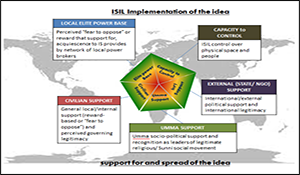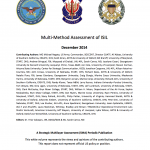Multi-Method Assessment of ISIL in Iraq and Syria

Multi-Method Assessment of ISIL.
Author | Editor: Cabayan, H. (Joint Staff) & Canna, S. (NSI, Inc).
SOCCENT has requested a short-term effort to assess the appeal of ISIL, specifically to answer, “What makes ISIL so magnetic, inspirational, and deeply resonant with a specific, but large, portion of the Islamic population allowing it to draw recruitment of foreign fighters, money and weapons, advocacy, general popularity, and finally support from other groups such as Boko Haram, several North African Extremist Groups, and other members of the Regional and International Sunni Extremist organizations?” A study was undertaken to understand the psychological, ideological, narrative, emotional, cultural and inspirational (“intangible”) nature of ISIL. This white paper summarizes results from analytical efforts and key results and observations.
The articles in this paper summarize work performed at the request of SOCCENT by numerous government agencies, academics, think tanks, and industry. The participants and SMEs consulted are listed in Appendix B. The work was performed over a period of four months (July-Oct, 2014). SOCCENT requested a short-term effort to assess the appeal of ISIL. Specifically, SMA2 was asked to answer the question, “What makes ISIL so magnetic, inspirational, and deeply resonant with a specific, but large, portion of the Islamic population allowing it to draw recruitment of foreign fighters, money and weapons, advocacy, general popularity, and finally support from other groups such as Boko Haram, several North African Extremist Groups, and other members of the Regional and International Sunni Extremist organizations?” The study attempted to understand the psychological, ideological, narrative, organizational, leadership, emotional, cultural and inspirational (“intangible”) nature of ISIL. The project included the development of an overall (Evolution & Longevity) framework (Section I) to synthesize the qualitative and quantitative analytical approaches for discerning the appeal of ISIL. In the process, interviews were conducted with over 50 SMEs from across the globe to gain insights into the core questions being asked (see Section II). The effort brought together different perspectives, disciplines, methodologies, and analytic approaches and sources to uncover real and apparent consistencies and inconsistencies among them and to identify how the individual pieces combine to provide a clearer picture of an issue.
Overall, there was qualified agreement on key factors explaining ISIL support—the differences are in the importance attributed to these factors by different SMEs and researchers.
On the question of ISIL longevity, the study uncovered two very different schools of thought:
- ISIL has resilient properties via its capacity to control people and territory stemming from pragmatic leadership and organization, intimidation tactics, tapping into existing Sunni grievances, use of a well-developed narrative and media outreach to attract and motivate fighters.
- ISIL is not a durable but rather an opportunistic group that 1) is taking advantage of a pre- existing sectarian conflict to acquire land, wealth, and power; 2) only attracts a narrow band of disaffected Sunni youth, 3) is alienating local populations by over-the-top violence and harsh implementation of Sharia; 4) is unable to expand into territories controlled by functioning states; and 5) does not possess the expertise required to form a bureaucracy and effectively govern.
Key insights provided that are of particular relevance to the operational community include:
- ISIL’s Capacity to Control is defined by its organizational skill and ability to use symbols, narratives, and violence (to intimidate or coerce).
- External Support – Sunni Muslim states’ main objective is power—not ideology. External support or opposition to ISIL could change rapidly based on new developments (e.g., if Shias are perceived to be winning the sectarian conflict).
- Local Elite Power Base (particularly in Iraq) is driven by elite desire to retain power and ISIL patronage, not primarily by ideology.
- Civilian Support is driven by coercion and fear, assessment of who offers better security and/or governance, and lack of viable alternative.
- Ummah Support – Radicalization is a very individualized process; there are many reasons why people sympathize, support, or join ISIL.
Key Study Observations:
- There was a significant focus in the group on the persuasive narratives ISIL uses. However, there is little evidence that the USG is well positioned to counter theses narratives, but the conditions that allowed ISIL to rise so quickly (weak states, Sunni sectarian grievances, youth bulge, unemployment, etc.) are things the USG and international community might affect over the long term.
- Beliefs about ISIL’s longevity generally fall into two camps: durable vs. flash in pan. However, a third possibility must also be considered: ISIL is a symptom of rising Islamist fundamentalism across the Muslim world combined with inequality and thwarted aspirations, declining sense of nationalism, and other pre-existing conditions including youth bulge, impact of the information revolution, drought, etc.
- The political environments and sources of acquiescence to, or support for, ISIL are different in Syria and Iraq and require more investigation. However, SMEs tended to speak about ISIL support in terms that generalized across the two. There is a danger in thinking about them the same way in terms of solutions and root causes.
Bottom line:
- ISIL exists in a very fluid context where exogenous forces can drastically alter its prospects for success, just as exogenous factors created the conditions that allowed the organization to flourish over the last two years.
- ISIL’s primacy is a relative one, due to a lack of both inspirational and pragmatic alternatives and its present coercive and intimidation tactics.
Please refer to Appendix A for an overview of the research findings presented in the report as they relate to 1) the Longevity-Evolution Framework, 2) why ISIL is so appealing, and 3) issues emerging from various workshops held in support of the SMA/SOCCENT effort.
Contributing Authors
MG Michael Nagata, US Army, Commander, SOCCENT, Director CJIATF; Ali Abbas, University of Southern California, CREATE, DHS; Scott Atran, ARTIS & University of Oxford; Bill Braniff, University of Maryland, START, DHS; Andrew Bringuel, FBI; Muayyad al-Chalabi, JHU-APL; Sarah Canna, NSI; Jocelyne Cesari, Georgetown University & Harvard University; Jacquelyn Chinn, Texas A&M; Jon Cole, University of Liverpool; Steven Corman, Arizona State University, Center for Strategic Communication, HSCB; Jonathon Cosgrove, JHU-APL; Allison AstorinoCourtois, NSI; John Crowe, University of Nebraska, START, DHS; Richard Davis, ARTIS & University of Oxford; Natalie Flora, FBI; James Giordano, Georgetown University; Craig Giorgis, Marine Corps University; Mackenzie Harms, University of Nebraska, START, DHS; Benjamin Jensen, Marine Corps University; Richard John, University of Southern California, CREATE, DHS; Randy Kluver, Texas A&M; Larry Kuznar, Indiana University–Purdue University, Fort Wayne, NSI; Gina Ligon, University of Nebraska, START, DHS; Leif Lundmark, University of Nebraska, START, DHS; Clark McCauley, Bryn Mawr College, START, DHS; William H. Moon, Department of the Air Force; Sophia Moskalenko, Bryn Mawr College, START, DHS; Dan Myers, Marine Corps University; Ryan Pereira, University of Maryland, START, DHS; Stacy Pollard, JHU-APL; Philip Potter, University of Virginia; Hammad Sheikh, ARTIS & University of Oxford; Johannes Siebert, University of Southern California, CREATE, DHS; Pete Simi, University of Nebraska, START, DHS; Lee Slusher, JHU-APL; Anne Speckhard, Georgetown University; Jason Spitaletta, USMCR, JS/J-7 and JHU/APL; Laura Steckman, Whitney, Bradley and Brown; TRADOC/G-2 Operational Environment Lab; Shalini Venturelli, American University; Jeff Weyers, University of Liverpool; Lydia Wilson, ARTIS & University of Oxford; Detlof von Winterfeldt, University of Southern California, CREATE, DHS

Comments